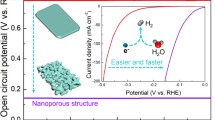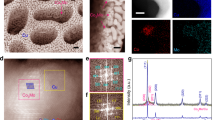Abstract
Water splitting is an environment friendly and efficient way to produce hydrogen. Highly efficient and low-cost non-noble metal catalysts play an important role in hydrogen evolution reaction (HER). Dealloying is a simple method to prepare three-dimensional self-supporting nanoporous materials without conductive supports and binders. In this work, we prepared self-supporting nanoporous CoBP electrocatalyst by dealloying method. The influence of the synergistic effect of nonmetallic elements on catalytic activity was investigated. The synergistic electronic effect of Co, B and P atoms on the surface optimizes the H atoms desorption and results in superior HER activity. The bi-continuous structure of nanoporous CoBP provides more active area and favors of electron and electrolyte transfer. The nanoporous CoBP with the B/P atomic ratio of 1/3 exhibits low overpotential of 42 mV at 10 mA·cm−2, small Tafel slope of 39.8 mV·dec−1 and good long-term stability with no performance decrease for 20 h in alkaline solution.
Graphic abstract







Similar content being viewed by others
References
Cipriani G, Di Dio V, Genduso F, La Cascia D, Liga R, Miceli R, Ricco Galluzzo G. Perspective on hydrogen energy carrier and its automotive applications. Int J Hydrog Energy. 2014;39(16):8482.
Singh S, Jain S, Ps V, Tiwari AK, Nouni MR, Pandey JK, Goel S. Hydrogen: a sustainable fuel for future of the transport sector. Renew Sust Energy Rev. 2015;51:623.
Mohammed-Ibrahim J, Sun X. Recent progress on earth abundant electrocatalysts for hydrogen evolution reaction (HER) in alkaline medium to achieve efficient water splitting—a review. J Energy Chem. 2019;34:111.
Xu C, Chen Q, Ding R, Huang S, Zhang Y, Fan G. Sustainable solid-state synthesis of uniformly distributed PdAg alloy nanoparticles for electrocatalytic hydrogen oxidation and evolution. Chin J Catal. 2021;42(2):251.
Yang X, Xu W, Cao S, Zhu S, Liang Y, Cui Z, Yang X, Li Z, Wu S, Inoue A, Chen L. An amorphous nanoporous PdCuNi-S hybrid electrocatalyst for highly efficient hydrogen production. Appl Catal B-Environ. 2019;246:156.
Zeng Y, Zhang J, Dong X, Zhang X, Jiang J. Pd based nanoporous metals with superior catalytic activity. Mater Res Innov. 2014;18(S4):734.
Jiang K, Liu B, Luo M, Ning S, Peng M, Zhao Y, Lu YR, Chan TS, de Groot FMF, Tan Y. Single platinum atoms embedded in nanoporous cobalt selenide as electrocatalyst for accelerating hydrogen evolution reaction. Nat Commun. 2019;10(1):1743.
Popczun EJ, Read CG, Roske CW, Lewis NS, Schaak RE. Highly active electrocatalysis of the hydrogen evolution reaction by cobalt phosphide nanoparticles. Angew Chem Int Ed Engl. 2014;53(21):5427.
Feng L, Vrubel H, Bensimon M, Hu X. Easily-prepared dinickel phosphide (Ni2P) nanoparticles as an efficient and robust electrocatalyst for hydrogen evolution. Phys Chem Chem Phys. 2014;16(13):5917.
Liu X, Zang J, Zhou S, Tian P, Gao H, Song S, Li R, Wang Y. Electroless deposition of Ni-Cu-P on a self-supporting graphene with enhanced hydrogen evolution reaction activity. Int J Hydrog Energy. 2020;45(27):13985.
Ye R, del Angel-Vicente P, Liu Y, Arellano-Jimenez MJ, Peng Z, Wang T, Li Y, Yakobson BI, Wei SH, Yacaman MJ, Tour JM. High-performance hydrogen evolution from MoS2(1 − x)P(x) solid solution. Adv Mater. 2016;28(7):1427.
Fu Q, Yang L, Wang W, Han A, Huang J, Du P, Fan Z, Zhang J, Xiang B. Synthesis and enhanced electrochemical catalytic performance of monolayer WS2(1 − x)Se2x with a tunable band gap. Adv Mater. 2015;27(32):4732.
Caban-Acevedo M, Stone ML, Schmidt JR, Thomas JG, Ding Q, Chang HC, Tsai ML, He JH, Jin S. Efficient hydrogen evolution catalysis using ternary pyrite-type cobalt phosphosulphide. Nat Mater. 2015;14(12):1245.
Ha DH, Han B, Risch M, Giordano L, Yao KPC, Karayaylali P, Shao-Horn Y. Activity and stability of cobalt phosphides for hydrogen evolution upon water splitting. Nano Energy. 2016;29(S1):37.
Li J, Wei G, Zhu Y, Xi Y, Pan X, Ji Y, Zatovsky IV, Han W. Hierarchical NiCoP nanocone arrays supported on Ni foam as an efficient and stable bifunctional electrocatalyst for overall water splitting. J Mater Chem A. 2017;5(28):14828.
Ma B, Yang Z, Chen Y, Yuan Z. Nickel cobalt phosphide with three-dimensional nanostructure as a highly efficient electrocatalyst for hydrogen evolution reaction in both acidic and alkaline electrolytes. Nano Res. 2018;12(2):375.
Vrubel H, Hu X. Molybdenum boride and carbide catalyze hydrogen evolution in both acidic and basic solutions. Angew Chem Int Ed Engl. 2012;51(51):12703.
Xu C, Peng S, Tan C, Ang H, Tan H, Zhang H, Yan Q. Ultrathin S-doped MoSe2 nanosheets for efficient hydrogen evolution. J Mater Chem A. 2014;2(16):5597.
Zhang P, Wang M, Yang Y, Yao T, Han H, Sun L. Electroless plated Ni–B films as highly active electrocatalysts for hydrogen production from water over a wide pH range. Nano Energy. 2016;19:98.
Irshad A, Munichandraiah N. Electrodeposited nickel-cobalt-sulfide catalyst for the hydrogen evolution reaction. ACS Appl Mater Interfaces. 2017;9(23):19746.
Li J, Zhuang Q, Xu P, Zhang D, Wei L, Yuan D. Three-dimensional lily-like CoNi2S4 as an advanced bifunctional electrocatalyst for hydrogen and oxygen evolution reaction. Chin J Catal. 2018;39(8):1403.
Sun J, Hu X, Huang Z, Huang T, Wang X, Guo H, Dai F, Sun D. Atomically thin defect-rich Ni–Se–S hybrid nanosheets as hydrogen evolution reaction electrocatalysts. Nano Res. 2020;13(8):2056.
Sun Y, Liu C, Grauer DC, Yano J, Long JR, Yang P, Chang CJ. Electrodeposited cobalt-sulfide catalyst for electrochemical and photoelectrochemical hydrogen generation from water. J Am Chem Soc. 2013;135(47):17699.
Ye TN, Lv LB, Xu M, Zhang B, Wang KX, Su J, Li XH, Chen JS. Hierarchical carbon nanopapers coupled with ultrathin MoS2 nanosheets: highly efficient large-area electrodes for hydrogen evolution. Nano Energy. 2015;15:335.
Fan H, Yu H, Zhang Y, Zheng Y, Luo Y, Dai Z, Li B, Zong Y, Yan Q. Fe-doped Ni3C nanodots in N-doped carbon nanosheets for efficient hydrogen-evolution and oxygen-evolution electrocatalysis. Angew Chem Int Ed Engl. 2017;56(41):12566.
Gao S, Chen H, Liu Y, Li GD, Gao R, Zou X. Surface-clean, phase-pure multi-metallic carbides for efficient electrocatalytic hydrogen evolution reaction. Inorg Chem Front. 2019;6(4):940.
Miao M, Pan J, He T, Yan Y, Xia BY, Wang X. Molybdenum carbide-based electrocatalysts for hydrogen evolution reaction. Chemistry. 2017;23(46):10947.
Xiao P, Ge X, Wang H, Liu Z, Fisher A, Wang X. Novel molybdenum carbide-tungsten carbide composite nanowires and their electrochemical activation for efficient and stable hydrogen evolution. Adv Funct Mater. 2015;25(10):1520.
Dong C, Kou T, Gao H, Peng Z, Zhang Z. Eutectic-derived mesoporous Ni–Fe–O nanowire network catalyzing oxygen evolution and overall water splitting. Adv Energy Mater. 2018;8(5):1701347.
Hu L, Xiong T, Liu R, Hu Y, Mao Y, Balogun MJT, Tong Y. Co3O4@Cu-based conductive metal-organic framework core-shell nanowire electrocatalysts enable efficient low-overall-potential water splitting. Chemistry. 2019;25(26):6575.
Zhou W, Wu M, Li G. Rambutan-like CoP@Mo-Co-O hollow microspheres for efficient hydrogen evolution reaction in alkaline solution. Chin J Catal. 2020;41(4):691.
Ling T, Yan DY, Wang H, Jiao Y, Hu Z, Zheng Y, Zheng L, Mao J, Liu H, Du XW, Jaroniec M, Qiao SZ. Activating cobalt(II) oxide nanorods for efficient electrocatalysis by strain engineering. Nat Commun. 2017;8(1):1509.
Sun X, Habibul N, Du H. Co0.85Se magnetic nanoparticles supported on carbon nanotubes as catalyst for hydrogen evolution reaction. Chin J Catal. 2021;42(1):235.
Zhu M, Yan Y, Yan Q, Yin J, Cheng K, Ye K, Zhu K, Yan J, Cao D, Wang G. In situ growth of Ni0.85Se on graphene as a robust electrocatalyst for hydrogen evolution reaction. Int J Hydrog Energy. 2020;45(17):10486.
Cheng N, Wang N, Ren L, Casillas-Garcia G, Liu N, Liu Y, Xu X, Hao W, Dou SX, Du Y. In-situ grafting of N-doped carbon nanotubes with Ni encapsulation onto MOF-derived hierarchical hybrids for efficient electrocatalytic hydrogen evolution. Carbon. 2020;163:178.
Cong M, Sun D, Zhang L, Ding X. In situ assembly of metal-organic framework-derived N-doped carbon/Co/CoP catalysts on carbon paper for water splitting in alkaline electrolytes. Chin J Catal. 2020;41(2):242.
Qin Q, Chen L, Wei T, Wang Y, Liu X. Ni/NiM2O4 (M = Mn or Fe) supported on N-doped carbon nanotubes as trifunctional electrocatalysts for ORR, OER and HER. Catal Sci Technol. 2019;9(7):1595.
Kibsgaard J, Tsai C, Chan K, Benck JD, Nørskov JK, Abild-Pedersen F, Jaramillo TF. Designing an improved transition metal phosphide catalyst for hydrogen evolution using experimental and theoretical trends. Energy Environ Sci. 2015;8(10):3022.
Yang X, Lu AY, Zhu Y, Hedhili MN, Min S, Huang KW, Han Y, Li LJ. CoP nanosheet assembly grown on carbon cloth: a highly efficient electrocatalyst for hydrogen generation. Nano Energy. 2015;15:634.
Hu G, Tang Q, Jiang DE. CoP for hydrogen evolution: implications from hydrogen adsorption. Phys Chem Chem Phys. 2016;18(34):23864.
Gupta S, Patel N, Miotello A, Kothari DC. Cobalt-boride: an efficient and robust electrocatalyst for hydrogen evolution reaction. J Power Sources. 2015;279:620.
Men Y, Su J, Du X, Liang L, Cheng G, Luo W. CoBP nanoparticles supported on three-dimensional nitrogen-doped graphene hydrogel and their superior catalysis for hydrogen generation from hydrolysis of ammonia borane. J Alloys Compd. 2018;735:1271.
Zhou Y, Liu H, Zhu S, Liang Y, Wu S, Li Z, Cui Z, Chang C, Yang X. Highly efficient and self-standing nanoporous NiO/Al3Ni2 electrocatalyst for hydrogen evolution reaction. ACS Appl Energy Mater. 2019;2(11):7913.
Erlebacher J, Aziz MJ, Karma A, Dimitrov N, Sieradzki K. Evolution of nanoporosity in dealloying. Nature. 2001;410(6827):450.
Tan Y, Wang H, Liu P, Cheng C, Zhu F, Hirata A, Chen M. 3D nanoporous metal phosphides toward high-efficiency electrochemical hydrogen production. Adv Mater. 2016;28(15):2951.
Chen Q, Sieradzki K. Spontaneous evolution of bicontinuous nanostructures in dealloyed Li-based systems. Nat Mater. 2013;12(12):1102.
Niu M, Xu W, Zhu S, Liang Y, Cui Z, Yang X, Inoue A. Synthesis of nanoporous CuO/TiO2/Pd-NiO composite catalysts by chemical dealloying and their performance for methanol and ethanol electro-oxidation. J Power Sources. 2017;362:10.
Staszak-Jirkovsky J, Malliakas CD, Lopes PP, Danilovic N, Kota SS, Chang KC, Genorio B, Strmcnik D, Stamenkovic VR, Kanatzidis MG, Markovic NM. Design of active and stable Co-Mo-Sx chalcogels as pH-universal catalysts for the hydrogen evolution reaction. Nat Mater. 2016;15(2):197.
Chen Z, Duan X, Wei W, Wang S, Ni BJ. Recent advances in transition metal-based electrocatalysts for alkaline hydrogen evolution. J Mater Chem A. 2019;7(25):14971.
Kim J, Kim H, Kim SK, Ahn SH. Electrodeposited amorphous Co–P–B ternary catalyst for hydrogen evolution reaction. J Mater Chem A. 2018;6(15):6282.
Shi Z, Nie K, Shao ZJ, Gao B, Lin H, Zhang H, Liu B, Wang Y, Zhang Y, Sun X, Cao XM, Hu P, Gao Q, Tang Y. Phosphorus-Mo2C@carbon nanowires toward efficient electrochemical hydrogen evolution: composition, structural and electronic regulation. Energy Environ Sci. 2017;10(5):1262.
Li BQ, Zhang SY, Tang C, Cui X, Zhang Q. Anionic regulated NiFe(Oxy)sulfide electrocatalysts for water oxidation. Small. 2017;13(25):1700610.
Zhao CX, Li BQ, Zhao M, Liu JN, Zhao LD, Chen X, Zhang Q. Precise anionic regulation of NiFe hydroxysulfide assisted by electrochemical reactions for efficient electrocatalysis. Energy Environ Sci. 2020;13(6):1711.
Popczun EJ, McKone JR, Read CG, Biacchi AJ, Wiltrout AM, Lewis NS, Schaak RE. Nanostructured nickel phosphide as an electrocatalyst for the hydrogen evolution reaction. J Am Chem Soc. 2013;135(25):9267.
Jiang R, Cui Z, Xu W, Zhu S, Liang Y, Li Z, Wu S, Chang C, Inoue A. Highly efficient amorphous np-PdFePC catalyst for hydrogen evolution reaction. Electrochim Acta. 2019;328:135082.
Acknowledgements
This study was financially supported by the National Natural Science Foundation of China (No. 51771131).
Author information
Authors and Affiliations
Corresponding author
Electronic supplementary material
Below is the link to the electronic supplementary material.
Rights and permissions
About this article
Cite this article
Guang, HL., Zhu, SL., Liang, YQ. et al. Highly efficient nanoporous CoBP electrocatalyst for hydrogen evolution reaction. Rare Met. 40, 1031–1039 (2021). https://doi.org/10.1007/s12598-020-01697-7
Received:
Revised:
Accepted:
Published:
Issue Date:
DOI: https://doi.org/10.1007/s12598-020-01697-7




